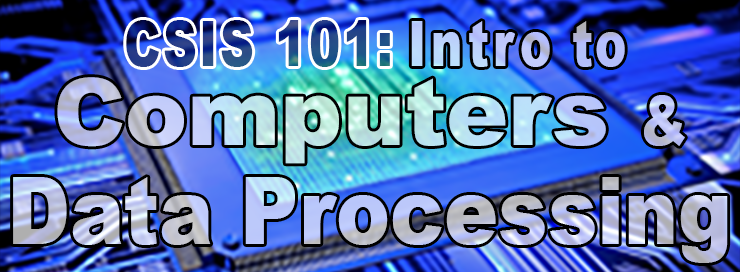Courses
Select a Course:

Course Description
This course provides a general introduction to computers and information technology. Students will explore the information processing cycle, with an emphasis on understanding the role of input, output, processing, and storage in modern information systems. Topics for this class include the history of computers, and contemporary issues in information technology. Students will learn to use word processing, spreadsheets, and database applications as a tool for improving personal productivity in an organizational setting.
By successfully completing this course you will earn 3 units of college credit.
⇑ Table of Contents
Course Objectives
-
Compare and contrast the constituent parts of an information system with an emphasis on input, processing, output, and storage.
-
Select an appropriate productivity application for a given task and compose and produce a graphically rich word processing document, a formula based spreadsheet, a relational database, and a media rich presentation. [note: not more than 25% of the contact hours and final grade should be dedicated to application software]
-
Classify current technology news and events in terms of Privacy, Intellectual Property, Government Regulation, Ethics, and other contemporary issues in information technology.
-
Relate the systems development life cycle (SDLC) to real-world projects.
-
Prepare a flowchart for simple process descriptions; compare and contrast programming control structures.
-
Solve for the Base2 (binary) equivalent of a Base10 value (decimal).
-
Diagram the communication channel, and propose appropriate communication media types to complete the channel (ie. twisted pair, fiber, etc.) given a general communication system description.
-
Propose an appropriate internet tool or resource to derive the answer given a specific Information task.
-
Investigate and assess new sources of information and learning opportunities to stay abreast of emerging information and computing technologies.
-
List career paths related to the program of study, as well as any qualifications and/or professional certifications that may be associated with those careers.
⇑ Table of Contents
Course Learning Outcomes
-
Insert a graphic into a word processing document (as it pertains to a problem/case scenario).
-
Format using numbers or bullets within a word processing document (as they pertain to a problem/case scenario).
-
Use the SUM function to calculate totals in a spreadsheet document (as they pertain to a problem/case scenario).
-
Create a formula to calculate a total in a spreadsheet document (as they pertain to a problem/case scenario).
-
Create speaker notes in a presentation document (as they pertain to a problem/case scenario).
-
Display slide numbers in a presentation document (as they pertain to a problem/case scenario).
-
Apply conditional formatting to a range of numbers in a spreadsheet document (as they pertain to a problem/case scenario).
-
Produce a SmartArt diagram by converting a list in a presentation document (as they pertain to a problem/case scenario).
-
Apply formatting to a paragraph in a word processing document (as it pertains to a problem/case scenario).
⇑ Table of Contents